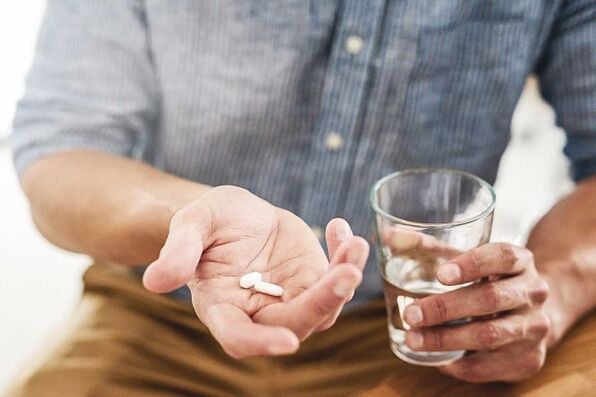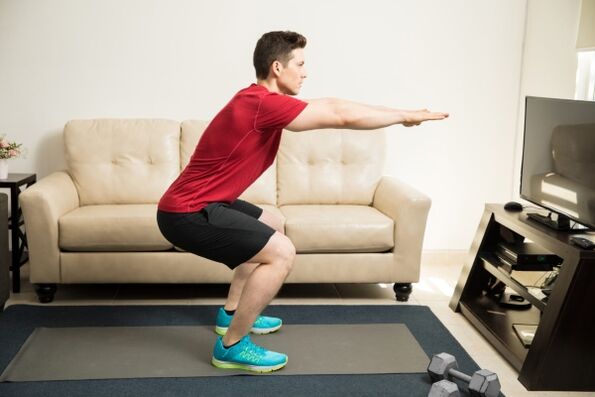Prostatitis is a rare disease that requires specific treatment. Therefore, it is important to know how it arises and what signs it is accompanied by. From this article you will learn about all the features of the disease. As well as methods of diagnosis and treatment.
For acute prostatitis, an inflammatory process is characteristic, in which masses with a dense structure are formed. In other words, these are stones located in the prostate gland. These include elements that enter the body of a man. They arise in the secretion of the prostate gland against the background of a chronic process of prostatitis, a pathological disorder.
Cause it happened
Prostatitis can be caused by the following:
- Genitourinary system infection. These can be diseases such as chlamydia, gonorrhea, trichomoniasis, ureaplasmosis, etc. v. During the reproduction and activation of pathological microorganisms, obstruction in the ducts of the prostate gland is noted, against the background of which the bile acquires a thick and viscous structure. Therefore, bacteria create a favorable environment for stone formation, and prostaglandins contribute to increased inflammation, leading to prostate blockage.
- Stagnation of all processes in the gland, which occurs for a variety of reasons - the presence of an adenoma (benign tumor) in the prostate gland, inactivity, the influence of harmful foods, abusealcohol, smoking. But the most frequent reason is the lack of regular sexual activity, since in this case the normal glands cannot clean the microvessels, and thus stagnation occurs.
- Urethral-prostatic reflux. In this disease, the liquid in the urine when urinating in small doses is expelled into the prostate gland. As urine accumulates, crystalline salts are released that, over time, increase and thicken, turning into stones. Urethral-prostatic reflux develops as a result of trauma to the urethra, atrophy of the prostate gland, prostatectomy, etc. v.
- The impaired blood circulation in the pelvic organs also leads to stagnation.
- Frequent hypothermia of the body and genitals.
- Failure to maintain personal hygiene causes infections that lead to prostatitis.
- Elderly. This is due to the fact that a plaque of phosphoric acid and lime is formed on the thickened epithelium and amyloid body.
The rock formations are yellowish in color and spherical. The minimum size of prostatolite is 0. 25 cm, the maximum is 0. 4. They are formed singly or in majority, they are mainly of the following types: phosphate stones, oxalate or urate stones.
The symptoms
The following signs indicate the presence of prostaglandins in the prostate gland:
- dull and aching pain in the perineum, groin, coccyx, scrotum;
- pain syndrome increases after physical activity, bowel movements, sex, prolonged sitting in one position;
- sharp pain when urinating;
- intermittent jet;
- frequent urination with urine retention;
- blood particles in urine and semen;
- premature ejaculation;
- weakening of potency;
- increased body temperature;
- insomnia;
- decreased appetite;
- psychological - emotional instability.
Stages of bacterial prostatitis
- Primary or catarrhal.In its primary form, stones form in the acini of the prostate gland or the ducts. The symptoms of a type of catarrhal are poorly expressed, the symptoms are the same as those of catarrhal pathologies. If you consult a urologist in time and start adequate treatment, you can recover from the disease in a week.
- Secondary or follicular.In the secondary form, the prostate gland enters the organ from the kidneys, bladder and other elements of the body against the background of urolithiasis. The appearance of a cyst can develop after an untreated catarrhal. The manifestations are acute, with an increase in body temperature and weakness, the duration of treatment is prolonged.
- Tertiary or parenchymal.With the tertiary form, the parenchyma of the prostate gland is affected, hence it is called the parenchyma (diffuse). This is the final stage of the acute episode, in which the symptoms are very acute. Purulent discharge forms on the inflamed area. The course of treatment is long, the tolerance is difficult.
Possible complications of prostatitis
What complications cause untreated prostatitis:
- abscess in the prostate against the background of accumulation of purulent fluid in the tissues;
- intoxication of the body with pus formations and the further development of sepsis, which causes death;
- atrophy of the prostate gland and as a result impotence;
- inflammation of the seminal vesicles in acute or chronic form with the manifestation of varicocele leading to impotence, infertility;
- cystitis and urinary incontinence.
To prevent those consequences, when detecting the first signs, it is necessary to go to the doctor and have a comprehensive examination.
How to reduce an attack at home?
It is quite understandable for ordinary people that during an attack it is necessary to call an ambulance brigade. But before she arrives, you can take your usual pain reliever. If your home medicine cabinet contains propolis-based rectal suppositories, perform the appropriate procedure. Pain reliever and laxative.
Which doctor is treating?
A urologist (or gynecologist) deals with the treatment of prostatitis of any kind. Other highly specialized physicians - nephrologists, infectious disease specialists and others, depending on the cause of stone formation - are also included in the diagnostic process and selection of treatment tactics. .
Diagnose
At the first visit to the urology clinic, the doctor conducts palpation and imaging tests, then he will collect a history. Lifestyle, the presence of certain pathologies and the nature of the signs of manifestation are necessarily taken into account. Furthermore, the following diagnoses are made:
- collection of blood and urine for meta-analysis to determine the number of structural units (components of biological fluids);
- collection of semen (sperm with prostatitis is characterized by an increase in the number of epithelial tissues and amyloid bodies);
- spermogram allows you to study the level of sperm motility and number;
- X-ray of the prostate gland;
- ultrasound examination of the prostate gland;
- computer or magnetic resonance imaging.
Blood sampling for PSA is required, which helps identify a specific prostate antigen (a type of prostate tumor marker).
Prostatitis treatment
The duration of treatment and the choice of therapeutic measures depend on the degree of neglect of the disease, as well as the form, the cause of development and the presence of complications.
Medicines for treatment
- The fluoroquinolone group is used to kill pathogenic bacteria, often the cause of prostatitis. These are antibiotics that can easily cope with many pathogens.
- Penicillin group of antibacterial agents.
- The tetracycline group of antibiotics. However, tetracyclines have a large number of side effects, so they are prescribed less often than other groups.
- Cephalosporins are administered intramuscularly.
- Non-steroidal anti-inflammatory drugs relieve pain syndrome, eliminate inflammation.
- Patients should take a multivitamin supplement to strengthen the immune system.

Surgical intervention
- Intravenous electrocautery allows you to remove stones and heal blood vessels. To do this, a high-frequency electric current and a urethoscope are used, which are inserted through the urethral lumen. The surgical procedure is painless, but there is a chance that prostatolite particles remain.
- Transoral surgery with ultrasound guidance. Unlike the previous method. Thanks to the increased ultrasonic tracking, all the microscopic deposits are eliminated.
- Prostatectomy (the stone is removed by dissection) and endoscopic (using a laparoscope inserted into the prostate gland). Along with stones in the omitted form, resection of the prostate gland, lymph nodes and seminal vesicles is performed.
- Lithotripsy involves using a laser to crush stones, which are then eliminated naturally. For this, an endoscope is used.
Physical therapy
- exposure to ultrasonic waves reduces the level of inflammation, eliminates pain;
- laser therapy accelerates metabolism in the prostate gland, reduces discomfort;
- Magnetic therapy restores blood circulation, neutralizes puffiness.
Massaging normalizes the circulation of the ducts, accelerates blood supply, is considered effective for prostatitis, but in the calculated form it is strictly forbidden. This is because prosatolite can move through the body.
If you do not have the opportunity to attend physical therapy procedures, you can do it at home using special equipment. But remember that physical therapy only has a palliative effect - when prostatitis is in an advanced stage, devices should not be used.
Diet therapy
A patient diagnosed with prostatitis of a compulsive nature must adhere to a special diet, developed by a dietitian at an individual level, based on the severity of the disease. pathological.
The basis of the diet is to refuse alcoholic and carbonated drinks, fried, smoked, salty and spicy foods. It is not recommended to use broths based on fatty meat and fish, mushrooms. Horseradish, turnips, radishes, garlic, cabbage, beans and onions will have to be excluded from vegetables. And the rest of the products lead to gas formation.
Physical therapy
It has always been used for prostatitis, but in its calculated form, the exercises should be gentle to prevent stone movement. Exercise should stretch the pelvic floor muscles. To do this, you can do the following exercises at a slow pace:
- Stand up in a chair and rest your hands on your back. Bring one leg to the side, lifting it as high as you can. Lower costs. The same actions are performed with the other leg. The number of hits is 8-10.
- Stand with your back to a chair and lean back. Raise your legs alternately to the level of your stomach, bending them at the knees.
- Spread your feet wider than shoulder-width apart, sit down and stay in the pose for a few seconds. Stand up. As you do the exercise, try to do stretchy movements in a squat. Repeat no more than 5 times.

Folk remedies
- Eat 25-30 pumpkin seeds daily, live and always hungry.
- Herbal decoction. You will need in equal proportions a naked ostudnik and a black letter. Set aside 1 tbsp. l. herbs, pour 0. 5 liters of "cold" boiling water in, to brew. Take 3 times a day, 100 mg half an hour before meals.
- Incubate persimmon roots according to the recipe stated on the medicine package. Drink as a tea drink three times a day.
- Pour 2 tablespoons into a cup of boiling water. l. Parsley seeds and simmer for 10-15 minutes. Emphasize hours. Drink up to 6 times a day, one tablespoon each time.
- Drink 600-1000 ml of fresh asparagus juice daily.
- Other natural juices are also useful - carrot, beetroot, cucumber.
Forecast
In the treatment of prostatitis, initially using conservative therapy, the outcome is often favorable. In neglected and non-aggressive forms of drug therapy, surgery is used. In this case, the prognosis is also favorable. But special attention should be paid to the rehabilitation period to prevent infection and other complications.
Preventive measures
To prevent the development of this type of prostatitis and prevent its recurrence, follow simple rules:
- get rid of bad habits;
- seek prompt medical help for any medical disorder;
- strictly follow the instructions of the urologist;
- do not overcool;
- use condoms to avoid infection;
- have an active sex life with a partner.


























